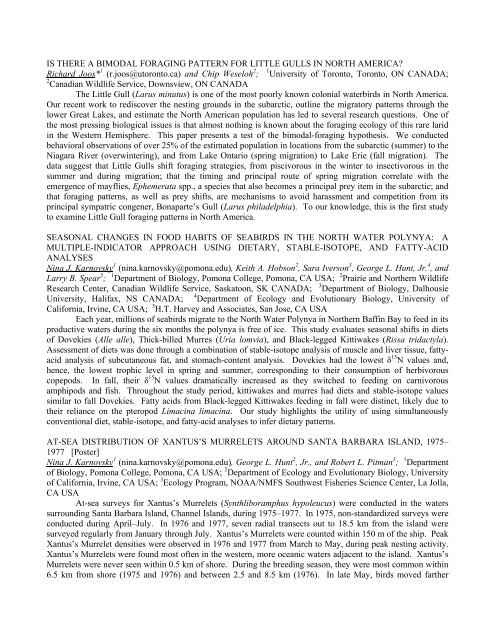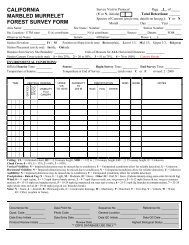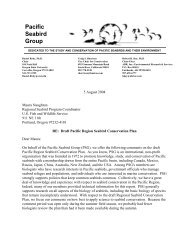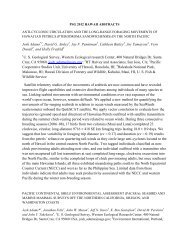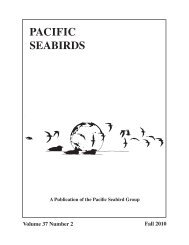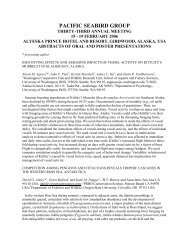abstracts of oral and poster presentations - Pacific Seabird Group
abstracts of oral and poster presentations - Pacific Seabird Group
abstracts of oral and poster presentations - Pacific Seabird Group
Create successful ePaper yourself
Turn your PDF publications into a flip-book with our unique Google optimized e-Paper software.
IS THERE A BIMODAL FORAGING PATTERN FOR LITTLE GULLS IN NORTH AMERICA<br />
Richard Joos* 1 (r.joos@utoronto.ca) <strong>and</strong> Chip Weseloh 2 ; 1 University <strong>of</strong> Toronto, Toronto, ON CANADA;<br />
2 Canadian Wildlife Service, Downsview, ON CANADA<br />
The Little Gull (Larus minutus) is one <strong>of</strong> the most poorly known colonial waterbirds in North America.<br />
Our recent work to rediscover the nesting grounds in the subarctic, outline the migratory patterns through the<br />
lower Great Lakes, <strong>and</strong> estimate the North American population has led to several research questions. One <strong>of</strong><br />
the most pressing biological issues is that almost nothing is known about the foraging ecology <strong>of</strong> this rare larid<br />
in the Western Hemisphere. This paper presents a test <strong>of</strong> the bimodal-foraging hypothesis. We conducted<br />
behavi<strong>oral</strong> observations <strong>of</strong> over 25% <strong>of</strong> the estimated population in locations from the subarctic (summer) to the<br />
Niagara River (overwintering), <strong>and</strong> from Lake Ontario (spring migration) to Lake Erie (fall migration). The<br />
data suggest that Little Gulls shift foraging strategies, from piscivorous in the winter to insectivorous in the<br />
summer <strong>and</strong> during migration; that the timing <strong>and</strong> principal route <strong>of</strong> spring migration correlate with the<br />
emergence <strong>of</strong> mayflies, Ephemerata spp., a species that also becomes a principal prey item in the subarctic; <strong>and</strong><br />
that foraging patterns, as well as prey shifts, are mechanisms to avoid harassment <strong>and</strong> competition from its<br />
principal sympatric congener, Bonaparte’s Gull (Larus philadelphia). To our knowledge, this is the first study<br />
to examine Little Gull foraging patterns in North America.<br />
SEASONAL CHANGES IN FOOD HABITS OF SEABIRDS IN THE NORTH WATER POLYNYA: A<br />
MULTIPLE-INDICATOR APPROACH USING DIETARY, STABLE-ISOTOPE, AND FATTY-ACID<br />
ANALYSES<br />
Nina J. Karnovsky 1 (nina.karnovsky@pomona.edu), Keith A. Hobson 2 , Sara Iverson 3 , George L. Hunt, Jr. 4 , <strong>and</strong><br />
Larry B. Spear 5 ; 1 Department <strong>of</strong> Biology, Pomona College, Pomona, CA USA; 2 Prairie <strong>and</strong> Northern Wildlife<br />
Research Center, Canadian Wildlife Service, Saskatoon, SK CANADA; 3 Department <strong>of</strong> Biology, Dalhousie<br />
University, Halifax, NS CANADA; 4 Department <strong>of</strong> Ecology <strong>and</strong> Evolutionary Biology, University <strong>of</strong><br />
California, Irvine, CA USA; 5 H.T. Harvey <strong>and</strong> Associates, San Jose, CA USA<br />
Each year, millions <strong>of</strong> seabirds migrate to the North Water Polynya in Northern Baffin Bay to feed in its<br />
productive waters during the six months the polynya is free <strong>of</strong> ice. This study evaluates seasonal shifts in diets<br />
<strong>of</strong> Dovekies (Alle alle), Thick-billed Murres (Uria lomvia), <strong>and</strong> Black-legged Kittiwakes (Rissa tridactyla).<br />
Assessment <strong>of</strong> diets was done through a combination <strong>of</strong> stable-isotope analysis <strong>of</strong> muscle <strong>and</strong> liver tissue, fattyacid<br />
analysis <strong>of</strong> subcutaneous fat, <strong>and</strong> stomach-content analysis. Dovekies had the lowest δ 15 N values <strong>and</strong>,<br />
hence, the lowest trophic level in spring <strong>and</strong> summer, corresponding to their consumption <strong>of</strong> herbivorous<br />
copepods. In fall, their δ 15 N values dramatically increased as they switched to feeding on carnivorous<br />
amphipods <strong>and</strong> fish. Throughout the study period, kittiwakes <strong>and</strong> murres had diets <strong>and</strong> stable-isotope values<br />
similar to fall Dovekies. Fatty acids from Black-legged Kittiwakes feeding in fall were distinct, likely due to<br />
their reliance on the pteropod Limacina limacina. Our study highlights the utility <strong>of</strong> using simultaneously<br />
conventional diet, stable-isotope, <strong>and</strong> fatty-acid analyses to infer dietary patterns.<br />
AT-SEA DISTRIBUTION OF XANTUS’S MURRELETS AROUND SANTA BARBARA ISLAND, 1975–<br />
1977 [Poster]<br />
Nina J. Karnovsky 1 (nina.karnovsky@pomona.edu), George L. Hunt 2 , Jr., <strong>and</strong> Robert L. Pitman 3 ; 1 Department<br />
<strong>of</strong> Biology, Pomona College, Pomona, CA USA; 2 Department <strong>of</strong> Ecology <strong>and</strong> Evolutionary Biology, University<br />
<strong>of</strong> California, Irvine, CA USA; 3 Ecology Program, NOAA/NMFS Southwest Fisheries Science Center, La Jolla,<br />
CA USA<br />
At-sea surveys for Xantus’s Murrelets (Synthliboramphus hypoleucus) were conducted in the waters<br />
surrounding Santa Barbara Isl<strong>and</strong>, Channel Isl<strong>and</strong>s, during 1975–1977. In 1975, non-st<strong>and</strong>ardized surveys were<br />
conducted during April–July. In 1976 <strong>and</strong> 1977, seven radial transects out to 18.5 km from the isl<strong>and</strong> were<br />
surveyed regularly from January through July. Xantus’s Murrelets were counted within 150 m <strong>of</strong> the ship. Peak<br />
Xantus’s Murrelet densities were observed in 1976 <strong>and</strong> 1977 from March to May, during peak nesting activity.<br />
Xantus’s Murrelets were found most <strong>of</strong>ten in the western, more oceanic waters adjacent to the isl<strong>and</strong>. Xantus’s<br />
Murrelets were never seen within 0.5 km <strong>of</strong> shore. During the breeding season, they were most common within<br />
6.5 km from shore (1975 <strong>and</strong> 1976) <strong>and</strong> between 2.5 <strong>and</strong> 8.5 km (1976). In late May, birds moved farther


